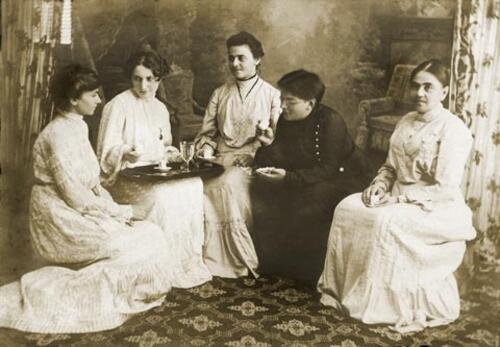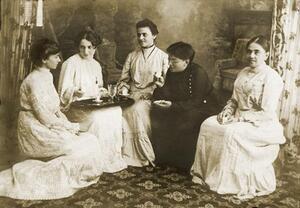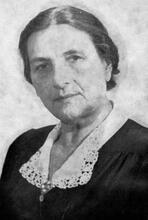Olga Belkind-Hankin
Olga Belkind, midwife and Zionist, meets with a group of women including Mania Shochat, a political activist and Zionist. (L to R): 1. Shoshana Feinberg, married Nahum Wilbush (Wilbushewitch, 1879–1971) 2. Doba Belkind, married Israel Belkind (1861–1929) 3. Alexandra (Sonia) Belkind (1858–1943), physician, married Menahem Hankin (1868–1937) 4. Mania Wilbushewitch Shochat (1880–1961), married Israel Shochat (1886–1961) 5. Olga Belkind (1852–1943), married Yehoshua Hankin.
Courtesy of Tamar Eshel
Belkind-Hankin was a professional midwife active in Palestine in the early 20th century. After moving to St. Petersburg as a young woman to study midwifery, her home there became a meeting place for Zionist students, writers, and thinkers. In 1886 Belkind-Hankin traveled to Palestine at the request of her family to help her pregnant sister. Soon after, she met and married Yehoshua Hankin, a Zionist activist who was involved in land purchase in Mandatory Palestine. They moved to Jaffa and Belkind-Hankin became well known in the community for her midwifery skills; she was most likely the first professional midwife in the country. During WWI, Belkind and her husband went into exile, and upon their return to Palestine in 1918, she retired from midwifery.
Education & Early Zionism
The oldest child of Meir and Shifra Belkind, Olga was born in the small town of Lahoysk (38 km NNE of Minsk) in 1852. She attended her father’s modern heder, learning Torah she-bi-khetav: Lit. "the written Torah." The Bible; the Pentateuch; Tanakh (the Pentateuch, Prophets and Hagiographia)Torah and Hebrew. As a young woman she decided to move to St. Petersburg to study midwifery. Since Jews were forbidden to live in the city unless they had studied a profession the authorities considered essential, she studied telegraphy and worked in the city’s railway station, helping her family with her salary. She began her midwifery studies but interrupted them briefly to move with her family to the district capital of Mohilev, where their home soon became a meeting place for young Jews who were deliberating on their Zionist path. She then returned to complete her studies in St. Petersburg where her two siblings, Shimshon (1865–1937) and Fania (Fanny Belkind Feinberg, 1860–1942), lived with her. Their home became a meeting place for revolutionary students, writers, and thinkers active in Members of Hibbat ZionHovevei Zion, as well as a shelter for women who gave birth out of wedlock.
The most prominent among those influenced by the nationalist awakening in Europe, especially in Italy and the Balkans, was a group of some fifty young students at the University of Kharkov and their friends. Despairing of universal and socialist ideals and believing they would never attain equal rights in Russia, they named their movement Bilu (an acronym of the Hebrew words of Isaiah 2:5, “Beit Ya’akov, lekhu ve-nelkhah”—House of Jacob, come let us go). Their goal was to establish a national pioneer movement, immigrate to Palestine, and set up a cooperative agricultural settlement that would serve as a model for all who came after them. Their group was the first among the Lovers of Zion who came to Ottoman Palestine.
The members of the Belkind family, especially Olga’s brother Israel (1861–1929) and sister Fania, stood out among the founders. Olga attended the movement’s meetings and also those of the female/sing.: Member of the Haskalah movement.maskilim and Hovevei Zion activists. Israel was among the first who moved to Palestine in the summer of 1882 and was followed by Fania two months later, while Olga remained in St. Petersburg to complete her studies. In 1886 she was called by her family to come in order to help her pregnant sister. She traveled to Palestine and came to Rishon le-Zion “to see her siblings and friends.... Intending to return and finish her university studies, she went for a ‘brief’ visit which lasted the rest of her life” (Smilansky 21).
Marriage & Midwifery

Olga Belkind, midwife and Zionist, meets with a group of women including Mania Shochat, a political activist and Zionist. (L to R): 1. Shoshana Feinberg, married Nahum Wilbush (Wilbushewitch, 1879–1971) 2. Doba Belkind, married Israel Belkind (1861–1929) 3. Alexandra (Sonia) Belkind (1858–1943), physician, married Menahem Hankin (1868–1937) 4. Mania Wilbushewitch Shochat (1880–1961), married Israel Shochat (1886–1961) 5. Olga Belkind (1852–1943), married Yehoshua Hankin.
Courtesy of Tamar Eshel
In Rishon le-Zion, in the course of a rebellion of farmers and workers who refused to accept the regulations of Baron Rothschild, who supported the colony, Olga met Yehoshua Hankin (1864–1945). His family, who were among the early settlers in En Kara (the Arab name of the settlement En ha-Kore) and founded the agricultural settlement of Rishon le-Zion, were among the first to leave after the failure of the rebellion against the Baron. Olga and Yehoshua were married in the agricultural settlement of Gederah in 1888 and a year later moved to the Ajami section of Jaffa, near the home of Yehoshua’s parents, Yehuda Leib and Sarah Hankin.
Yehoshua was known as the most important land buyer among the Jews, purchasing the land of the several colonies and of the Valley of Jezreel. Before the establishment of the state of Israel, the purchase of land was of utmost importance in the Zionist endeavor.
Olga, an “elegant, professional woman,” was twelve years older than Yehoshua and many people doubted whether the relationship between the young man of twenty-four and the thirty-six-year-old midwife would last. While Yehoshua hurried from place to place in an effort to purchase land for Jewish associations and companies who wished to settle in Palestine, Olga delivered babies. She was probably the first professional midwife in the country. Previously, the medical standard in the country had been extremely primitive. She became well-known among the Arabs of Jaffa—effendis, sheikhs, and Bedouin tribal leaders who lived on the sandy stretches south of the city. At the end of the 1880s, no one yet believed in Yehoshua’s skill as a real-estate agent, but they trusted Olga. Contemporary photographs show her holding a whip to protect herself while riding on a white donkey among the Bedouin tents and in the streets of Jaffa. On one occasion, while she was delivering the infant son of a wealthy Christian Arab of Jaffa who owned land south of the city, she learned of ten thousand dunams (acres) for sale in Wadi Deiran. She told Yehoshua about this, and in 1890 he completed his first land deal. That same year the Lit. "village." The dominant pioneer settlement type of the Jews in Palestine between 1882moshavah of Rehovot was founded on the site.
While Hankin was involved in buying lands in 1890 and 1891, a great crisis broke out. This crisis, caused by the growing demand for land, the profiteering that accompanied its purchase, and the Turkish decrees concerning land purchase and settlement in Palestine, left Yehoshua penniless. The purchases he had begun were cancelled and creditors started to pursue him. Over the next few years his world fell apart, while Olga continued to deliver the babies of the women of Jaffa and the surrounding area and pay her husband’s debts.
Things changed profoundly in 1908, when the Palestine Office, the representative of the Zionist Organization ,was established to manage affairs in The Land of IsraelErez Israel, and with it the Israel Land Development Company, which acted as its agent in purchasing land and selling it to Jewish buyers. Yehoshua Hankin was invited to join; his fluency in Arabic, his expertise both in Turkish law and in the customs of the Arabs of Palestine, and especially his wide acquaintanceship with the landowners continued to earn him a reputation as more knowledgeable on land in Erez Israel than any other dealer or agent. In 1910, when Hankin bought the land of the village of Fula in the Jezreel Valley, Olga was fifty-eight years old, but neither her age nor Hankin’s success stopped her from continuing to work as a midwife, in the hope that the difficult years would never return. When World War I broke out, Hankin, like many Zionists in Palestine, was charged with treason, arrested, imprisoned in Jerusalem, and deported to Sivas in Anatolia. Olga went into exile with him even though she was not required to do so. They traveled by train and coach for a month until they reached Istanbul. The intervention of the American consul in Turkey led to their place of exile being changed from Sivas to Bursa, where they remained until they were permitted to return to Palestine. On September 7, 1918, Olga and Yehoshua returned, first to Haderah and then to Tel Aviv. In October 1918 Olga received a British passport.
Later Life & Legacy
Olga retired from midwifery after their return to Palestine. As Yehoshua became ever more successful, purchasing some 600,000 dunams of land throughout Palestine, Olga remained in his shadow, forgotten. When Yehoshua turned seventy-five, a house was named after him in Kfar Yehoshua, but Olga was not present. She died two years later, in 1943, and was buried in the grave Yehoshua had prepared. As the author and the citrus grower Moshe Smilansky wrote in 1946: “On Mount Gilboa, facing his mighty land enterprise in the Jezreel Valley, Hankin dug a grave for her. He had prepared these graves here for her and for himself while she was still alive. He mourned deeply for the companion who had shared in all his life’s work. Year after year he visited her grave, accompanied by the children of the Jezreel Valley and their teachers.” He died two years later, in November 1945, and was buried beside Olga.
While streets named for Yehoshua Hankin exist in almost every city in Israel, only one street in Tel Aviv (Belkind Street) and one neighborhood in Haderah (Givat Olga) commemorate his wife. Few people know that the neighborhood got its name from the home Yehoshua built for himself and his wife on a calcareous sandstone (Kurkar) cliff overlooking the Binyamin Bay, south of Nahal Haderah. The house is still there, on the border of the large land purchase Hankin made in 1891 for the private associations that founded Haderah. It overlooks the lands of the coastal plain which Yehoshua Hankin bought in the 1920s and 1930s, a memorial to the childless couple, their work and their love.
Yaari, Y. Yehoshua Hankin: The Man and His Work. Tel Aviv: 1933.
Laskov, S. (ed.). Leibovitch, Dov Ariel. The Agricultural Community of Gederah: Its History and Development, 1882–1900. Jerusalem: 1991.
Smilansky, M. Yehoshua Hankin. Jerusalem: ha-Karen ha-Keyemet le-Yisrael, 1946.
Aner, Z. Family Stories: The Stories of Fifty Families of the Yishuv. Tel Aviv: 1990.
Amit, Irit. “Olga’s Houses.” Et-Mul 28 (169): 27–30.
Amit, Irit. “Projects for the Settlement of Jews in the Sanjak of Acre, 1902–1903.” Cathedra 49: 103–116.
Amit, Irit, and R. Kark. Hankin: Two Loves. Tel Aviv: Milo, 1998.
Bachi Kolodny, Ruth. If You Go Along with Me: The Story of Olga Hankin. Jerusalem: 1980.
Kark, R. “Geographical Aspects in the Ideology of Yehoshua Hankin.” Studies in the Geography of Israel 11: 101–113.
Kark, R. “Land Acquisition in Emek Hefer.” In Ha-Sharon: Between Yarkon and Carmel, edited by A. Degani, D. Grossman and A. Shmueli, 345–362. Tel Aviv: 1990.




